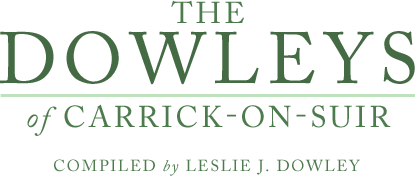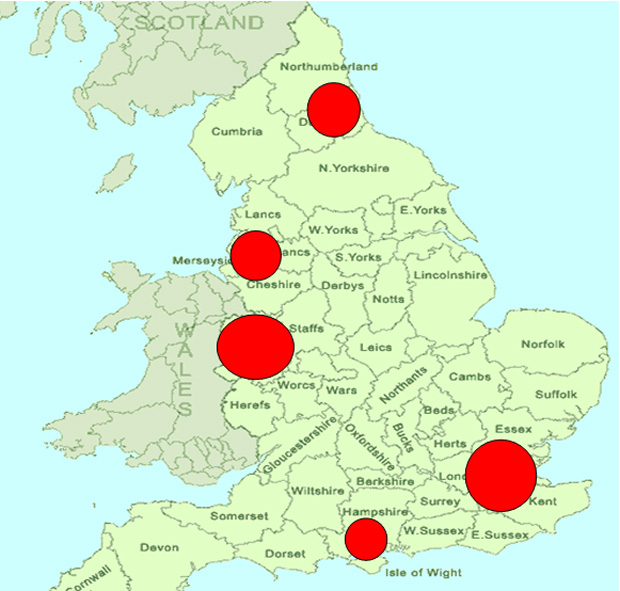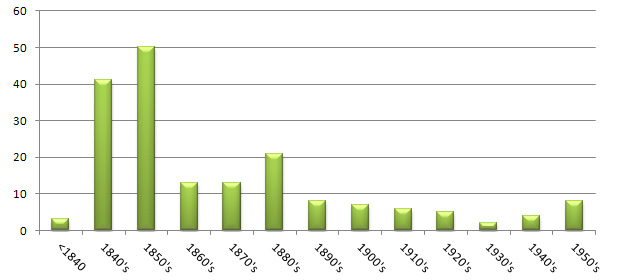The four Masters refer to O’Dooley as O’Dubhlaoich, describing their chiefs in the eleventh and twelfth centuries as Lords of Fertullagh, which is in the south-eastern end of Co. Westmeath. They were driven out by the O’Melaghlins and Tyrells and migrated to the Ely O’Carroll country which consisted of most of Offaly and some of north-west Tipperary. While the 1901 census would confirm a large number of Dooleys in this area, there is not a single Dowley. This would strongly suggest that Dowley was a separate name from Dooley even though the pronunciation was normally the same.
A very old treatise on Irish family names asserts that the name Dowley is an anglicization of the French D’Owlais. It appears that a French Huguenot of that name, a miller, fled with very many of his religious compatriots from Brittany circa 1570 to avoid the massacres being inflicted on his co-religionists. The emigrants sought refuge both in England and in Ireland and it is to be noted that many millers were among the refugees11.
It is suggested that the first D’Owlais came to the townsland of Tinvane near Carrick-on-Suir and purchased or were awarded some lands and built the first water powered flour mill on the Lingaun river, a tributary of the Suir11.
This is not consistent with the fact that there were Dowleys recorded in Carrick as early as 15511 and earlier in the Waterford area4. Some of the confusion may arise from the variation in spelling which was common at that time.
Patrick C. Powers book on Carrick-on-Suir and its people states that there were Dowleys in Carrick as early as the sixteenth century1. In 1551, one William Dowley was on the list of “Jurors of Carrick” and as such must have been a person of some substance. It is not possible at this stage to establish which family line he belonged to, but it is possible that he was one of the progenitors of some or all the Dowley lines in the Carrick area.
From the Hearth Money Rolls there was a Richard “Dowly” who was a land owner in Carrick in 1664. There was also a Teigh Dowley of Figlassy (Figlash) which is only about 3 miles from Tinvane as the crow flies.
The Dowley Name
The earliest reference to the Dowley name according to Hubert Galway of Faithlegge, Woodstown, Co. Waterford (near Dunmore East) is in an old law book referring to a law case in the 1100’s between a Dowley and the Duke of Leinster11. The name also appears in a list of financial contributors towards the building of St. John’s Infirmary in Waterford City in the thirteenth century4. It appears that the Dowleys were an Irish Catholic tribe in Co. Waterford who were known as Na Dubhlaoich (The Black Warriors) and centred somewhere around the Comeragh mountains in County Waterford4. These facts cannot be confirmed at present, but the Irish spelling of O’Dubhlaoich is now in widespread use for Dowley, Dooley and Dowling. The first known reference of a Dowley in Carrick-on-Suir is for the above William Dowley in 15511.
The spelling of names prior to the middle of the nineteenth century did not have the same significance that it has now. This resulted in several variations of the name such as Dovley, Dovlly, Dowley, Dowly, Dooly, Dooley and Dowling. Around the Carrick-on-Suir area as late as the mid-twentieth century the name Dowley was invariably pronounced “Dooley” irrespective of the spelling. The pronunciation as “Dowley” seemed to be reserved for the many branches of the Tinvane Dowley family and then only used by their family members and friends.
Information from Niall Quirk (M. JO’N Quirk, Solicitors, Carrick-on-Suir) would confirm that in the 1700’s and 1800’s there were variant spellings of the name such as Dooly, Dowly, Dooley and Dowley even when referring to the same person in the same document.
Family folklore suggests that in the tribal days the “Dowleys” controlled a vast tract of land east of the Comeragh Mountains including Curraghmore. They lost most of this in the 12th century and were forced back towards the Comeraghs again4. This again cannot be verified.
The Dowley Centre of Origin
By the beginning of the third millennium there were Dowleys living in many parts of Ireland as well as the UK, Europe, Australia, Africa, and the United States of America. However, in Ireland, up to the middle of the twentieth century, the name was largely confined to the Diocese of Waterford and Lismore, which includes parts of south Tipperary. Dowleys could also be found in parts of south Kilkenny. The main town in this area of north Waterford and south Tipperary is Carrick-on-Suir and this is where most of the Dowleys involved in agriculture and trade were located. It can be seen from the map, that most of the Dowleys were located near to the river Suir, which was probably the single most important natural resource in the area.
The national census identifies the residency of all 118 Dowleys present in Ireland on the night of Sunday, March 31st, 1901 and all 104 Dowleys present in Ireland on the night of Sunday, April 2nd, 19112. It can be seen from chart below that over 90% of all Dowleys were in the three counties of Kilkenny, Tipperary and Waterford. The vast majority of these (>80%) were within a 10 mile radius of Carrick-on-Suir. The people in religious orders and boarding schools have been repatriated for this purpose.

Area where most of the Dowley family resided in 1911. Tinvane Dowleys are marked in RED and Ballyknock Dowleys are marked in BLUE.
It is interesting to note that most of the Ballyknock Dowleys resided south of the river Suir while most of the Tinvane Dowleys resided north of the river. The remainder lived in Carrick-on-Suir or Carrick-beg.
Despite the suggestions of Fr. Michael Dowley3 that the family originated around Killworth in Co. Cork, the 1901 and 1911 census figures strongly suggest that the Dowley family originated somewhere in the south Tipperary or north Waterford area. This would be supported by the fact that at the time of each census there were no Dowleys residing in Co. Cork or West Waterford.
Comparison of the 1901 and 1911 census would confirm that there are a number of errors in these records especially in relation to the ages of individuals. This may be explained by the fact that the Pensions Act was introduced in 1908 and apparently many of the older males increased their age in order to avail of the pension. It is also evident that there was a considerable level of migration between years, with whole families appearing and disappearing. One could assume that most of this migration was back and forth between the UK, but some familes disappeared through death of males and marriage of females.
During this ten year period the families in Whitestown, Killerguile, Castlecomer and Danesford disappeared while the Westmeath Dowleys appeared for the first time in 1911.
The main families in the Carrick area were located in Ballyknock, Tinvane, Waterford Rd., Mothel Rd., New Lane, Coolnamuck Rd., Mill St., Clareen St. and Carrick-beg.

% Dowley population by County from the 1901 and 1911 census figures
(Total of 118 and 104 individuals respectively)
The Different Carrick-on-Suir Dowley Families
There are currently at least seven distinct Dowley families based around Carrick-on-Suir. These include the Ballyknock Dowleys, the Baker Dowleys, the Boatmen Dowleys, the Coolnamuck Rd. Dowleys the Mothel Rd. Dowleys, the Seskin Dowleys, and the Tinvane Dowleys. No relationship is currently claimed between these different branches of the Dowley family or can be confirmed by any of the research to-date. However, the fact that the name was nearly exclusive to the Carrick-on-Suir area would suggest that some relationship must have existed, at least in the distant past.
According to the Ancestry.com web-site, the most common names for the male Dowleys were Michael, John, Patrick and Thomas while the most common names for the females were Mary, Bridget, Margaret, Johannah and Ellen.
A summary of the 1901 and 1911 census returns for all Dowley families in Ireland is given in Appendix 1.
In 1899, when the first Urban District Council (UDC) was elected in Carrick-on-Suir, it contained two members of the Quirk family as well as Edward Dowley (Tinvane), Kyran Dowley (Castle St. and Ballyknock) and J. Ernest Grubb.
THE UK DOWLEYS
Main population areas of UK Dowleys
According to the Ancestry.co.uk web-site there were 843 Dowley deaths in the UK between 1786 and 1991 and during the same period there were some 1,200 births. While Dowley families could be found in most geographical areas of the UK they were very much concentrated into five distinct areas. These were London and the surrounding counties, the Shropshire/Staffordshire area (especially Shewsbury), Tyneside in the North East, the Liverpool/Manchester area and the Portsmouth/Southampton area in Hampshire. The Tinvane and Coolnamuck Rd. Dowleys seemed to rank high in terms of UK births although other families must also be involved.
EMIGRATION
Emigration and immigration would have been a regular fact of life for the people of Carrick-on-Suir during the 1800’s. The Dowleys were no exception to this phenomenon which would have been made easier by virtue of the proximity of ports such as Waterford and Cork.
Statistics for those entering the UK are not easy to acquire as Ireland was at that stage part of the British Isles and passenger lists between Ireland and the UK are not available. However, statistics for emigrants entering the US and Canada are more accessible if not complete.
The main Dowley exodus to the US and Canada was during the Great Famine and for the decades following the famine. Thereafter the numbers reduced to about one per year. Unfortunately, the data rarely records the exact place of birth which makes it difficult to trace the individuals to a particular family in Ireland.
Leslie J. Dowley
lesdowley@eircom.net



My grandfather, Thomas Dowley lived at Beech Farm near Piltown and Fiddown. Am not sure if cousins still live there. This Thoams Dowley married Hanorai O’Shea or perhaps Shea and they had two children Joseph and Anastasia, my mother. I know nothing more than that because of my mother’s death in England in 1955 This is all so interesting to me.
Hi Patricia, I’m the daughter of Tom Dowley from Beech Farm. Tom is your first cousin and is the son of Joe Dowley. You also have two other first cousins living in Dublin. Joe and Noreen Dowley. My father Tom would love to get in contact with you. You could reach us on mimdowley@gmail.com
Kind regards,
Miriam Dowley
Patricia you do your family honor. This was the best analysis of a family history I have seen. Like yours the Shanahan history has huge gaps, between their expulsion from County Clare in 1318, and showing up in Carrick history four hundred years later.
Nice work.
I just wanted to drop you a note and let you know how much I have enjoyed reading your family history. My cousin and I are are attempting to produce a similar narrative for our own family.
My Kennedy family originated in the Rathgormack- Mothel area. My 2nd great grandparents (Maurice Coleman and Ellen Power) were married by Fr Dowley at Clonea in 1856. My great grandmother (Johanna Coleman) went to the Clonea school.
Johanna Coleman was born in Kilnasbeg and married John Kennedy,born in Ballyquin. He was son of William Kennedy and Bridget Drohan. William worked as a gardener at Curraghmore. This Kennedy family emigrated to the US in 1880, the property that they lived on in Mayfield /Rocketscastle was later occupied by the Shanahans.
I visited the area this past spring. I love seeing all of the familiar names and places in your story.
Kathy (Kennedy) Kelley
Wow very interesting stuff. I never knew the name was that old,it’s great to find a bit out about where It’s come from. My father is a William Dowley and I’m told my grandfather and his father were both from carrick on suir. Thanks for this great article.
a big hello from the dowleys from mayfield cork
My great great grandmother is Ellen Dowley Lennon. She married William Lannen in Carrickbeg on 23rd. February 1852. They were married by Fr John Dowley. Witesses were Thomas Power and Catherine F. Kearney. They had seven boys and I girl. The girl Mary died aged 21years in 1882. Ellen died on 3rd. March 1890 aged 65 years and is buried in the Lennon Family Plot in Ballylaneen Graveyard, Kilmacthomas. One of their sons joined the priesthood, Fr John Lennon and died as Parish Priest of Stradbally in 1934.
Can you help me to find the connection with the Dowley Families of Carrickbeg.
Thanking you most sincerely.
Laura O Donnell
0868804640
This is a marvellous site, so well laid out & packed full of Dowley information.
I am sorry to read of the death of Leslie J.Dowley, he was clearly well loved & admired by many.
My thanks to those keeping the site standing.
I have hit a Dowley brick wall & I wonder if anyone could help me?
My Great Grandfather Thomas Dowley, born 1870-ish was adamant in his spelling of his surname & place of origin (Dublin) many times over. I have found him as follows:
1894-1896 Irish Merchant Navy listings as fireman Dublin to Liverpool;
1895 Married in Dublin South, to Sarah Scott/Meleady (Liverpool resident);
1898 Catholic Baptism records Liverpool for daughter Mary;
1901 E&W Liverpool census;
1901 Catholic Baptism records Liverpool for son Thomas;
1904 Catholic Baptism records Liverpool for daughter Elizabeth;
1907 Catholic Baptism records Liverpool for son Peter;
1911 E&W Liverpool census;
1921 Death Liverpool age 50.
Yet I cannot find when & where he was born in Ireland.
More recently has anyone done some DNA based Dowley family research?
Will I find them on Ancestry? My Heritage? Gedmatch?
Any suggestions for fruitful searching are welcome.
Martha
The Dowley clan can be very proud of Canada’s great folk artist Maud Kathleen Dowley – Maud Lewis – from Marshalltown, Nova Scotia. She created thousands of paintings in a small house where she lived out her life in poverty. Her parents were John and Agnes Dowley.
I hope you might take the time to look up her simple, beautiful style which captured rural life in Atlantic Canada and find the movie Maudie about her life. – MaryJane MacLennan
I want to keep this website alive and current as it’s a fascinating read. It’s 2025 and descendants of John Dowley (b.1934) in Carrick-on-Suir. Grandson Sean Dowley was married in 2015 to Meredith Sadler and have had two children. Thomas Dowley (b.2017) and Eliza Dowley (b.2020).
Also his Grandaughter, Grace Dowley married George Poole in 2024 and they are expecting their first child this year.